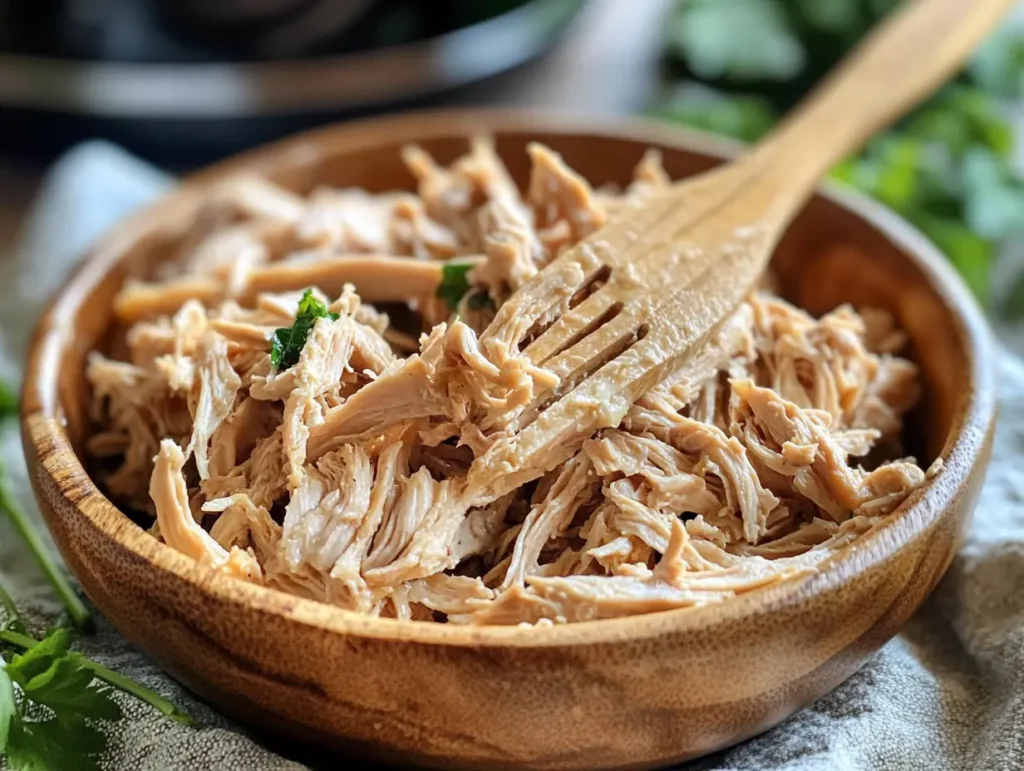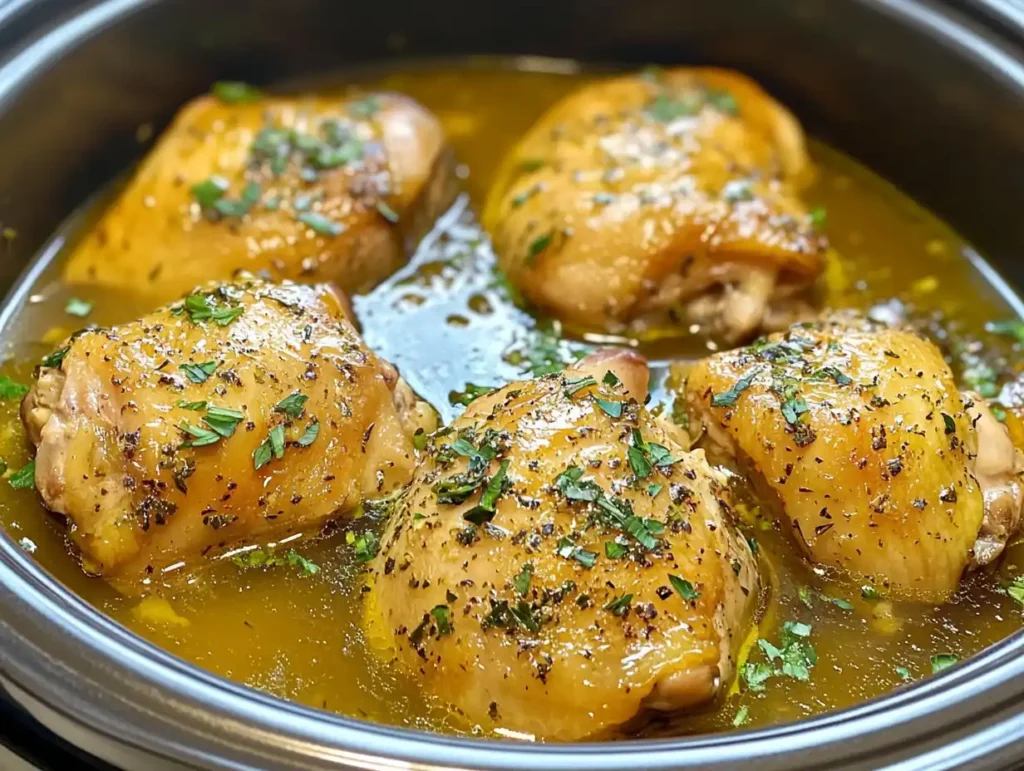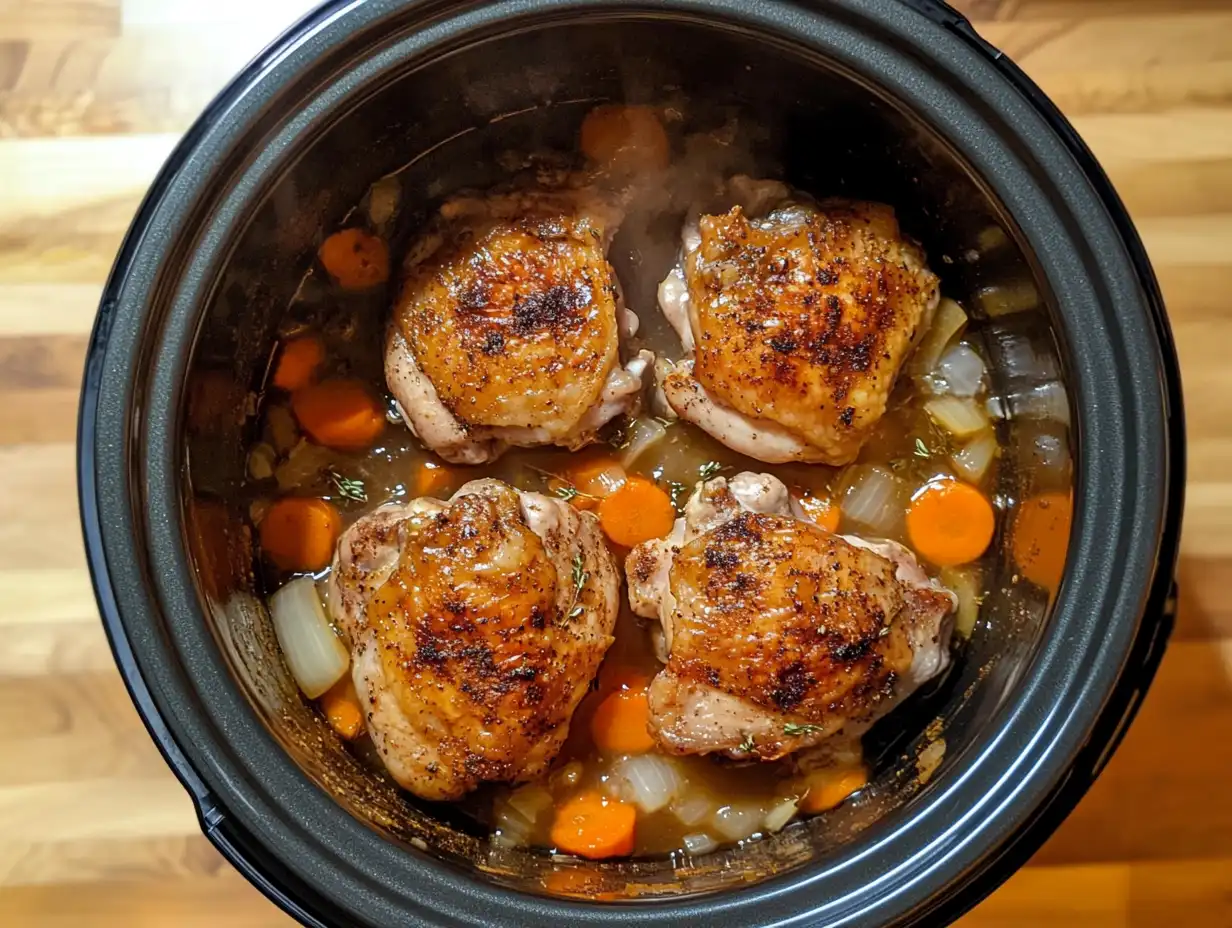Find out if chicken should be fully submerged in a slow cooker, plus expert tips and flavorful recipes.
Table of contents
Cooking chicken in a slow cooker can yield tender, juicy results. However, many home cooks wonder: Does chicken need to be submerged in slow cooker? Understanding the proper liquid level makes a big difference in your final dish. Indeed, adding the right amount of broth or sauce can help ensure moist, flavorful meat. Nevertheless, it is not always necessary to cover your chicken entirely. Altogether, whether you choose to submerge or not depends on personal preference, the recipe’s goals, and the chicken cuts you use. Consequently, this guide will explore the factors that influence how much liquid you need, offer practical tips, and provide a simple recipe to help you master the art of slow cooking chicken.
Slow Cooker Basics
Slow cookers operate at low temperatures over long periods. Accordingly, they allow flavors to develop gradually. Because they trap steam, these devices create a moist environment that often prevents meat from drying out. Yet, a common question arises: Does chicken need to be submerged in slow cooker or can it cook well with partial coverage?
Generally, chicken placed in a slow cooker releases moisture as it cooks. Comparatively, bone-in thighs may yield more juices than lean, boneless breasts. Thus, the cooker environment becomes naturally moist, even if you add only a small amount of liquid initially. Particularly, slow cookers produce condensation that drips back into the pot, reducing the risk of dryness.
Furthermore, when using a slow cooker, it is crucial to ensure that the chicken reaches a safe internal temperature of 165°F. Basically, this ensures food safety. Eventually, with or without full submersion, the chicken should become tender, as the gentle heat breaks down connective tissues. Indeed, the main concern is flavor and texture rather than dryness. Submerging chicken may lead to a softer, more “stewed” texture, while partial coverage can promote richer, concentrated flavors.
Does Chicken Need to Be Submerged in Slow Cooker for Proper Tenderness?
Cooking chicken in a slow cooker is a time-tested method for creating tender, juicy, and flavorful results. However, a common debate arises: should the chicken be fully submerged in liquid to achieve the desired tenderness? The answer largely depends on the type of chicken, the intended dish, and your personal taste preferences. Below, we’ll break down the key factors to consider when slow-cooking chicken to ensure a perfect balance of texture, flavor, and moisture.
Does Chicken Need to Be Submerged in Slow Cooker for Achieving Tenderness?
The question of whether full submersion is necessary for tenderness depends on the slow cooker’s environment. Slow cookers are designed to trap heat and moisture, creating a humid cooking space that softens connective tissues in the meat over time. Even when chicken is not fully submerged, it can become tender because:
- Natural Juices Release During Cooking: Chicken, especially bone-in cuts, releases moisture as it cooks. These juices combine with the small amount of liquid you add, effectively basting the chicken throughout the process.
- Steam Circulation: Slow cookers seal tightly, allowing steam to circulate and prevent the chicken from drying out. Even if the chicken sits above the liquid, the enclosed environment ensures it stays moist.
- Cut and Size Matter: Smaller cuts, like boneless breasts, require less liquid to stay tender compared to larger pieces or whole chickens, which may benefit from full submersion.
When to Submerge: If you are making a broth-based dish or want a very soft, poached texture, full submersion is ideal.
When to Partially Cover: For recipes like pulled chicken, casseroles, or dishes requiring a thicker sauce, partial submersion is sufficient and may even enhance flavor concentration.
Does Chicken Need to Be Submerged in Slow Cooker When Using Thighs?
Chicken thighs are prized for their rich flavor and resilience in long cooking processes. These cuts contain more fat and connective tissue, making them an excellent choice for slow cookers. Whether to submerge thighs or not depends on the texture and flavor profile you want to achieve.
- Submerging Chicken Thighs:
- When thighs are fully submerged, the connective tissue breaks down into gelatin, creating a soft, braised texture.
- This approach is perfect for dishes like chicken soup, chicken curry, or stews where tenderness and a gentle texture are desired.
- Submerging also ensures even cooking, especially when working with larger, bone-in thighs.
- Partially Covering Chicken Thighs:
- If you prefer a deeper, roasted flavor, partially covering the thighs allows the top portion to caramelize slightly.
- The exposed surface of the chicken browns slightly in the slow cooker, which adds complexity to the flavor profile.
- Partial submersion is ideal for shredded chicken recipes, where concentrated flavors work best.
Tip for Thighs: To add a crisp or caramelized texture, finish the thighs under the broiler for 3–5 minutes after slow cooking.
Does Chicken Need to Be Submerged in Slow Cooker for Bone-In Cuts?
Bone-in chicken cuts, such as drumsticks, thighs, or even a whole chicken, are excellent candidates for slow cooking. The bones play a crucial role in enhancing the flavor and texture of the dish.
- Full Submersion for Uniform Tenderness:
- Submerging bone-in cuts ensures even cooking, as all parts of the chicken are exposed to the same level of heat and moisture.
- This technique works well for dishes like chicken stew or poached chicken, where you want the meat to be ultra-soft and shred easily.
- Collagen from the bones melts into the cooking liquid, enriching it and creating a luxurious sauce or broth.
- Partial Submersion for Flavor Concentration:
- Partial submersion allows the exposed parts of the chicken to develop a slightly roasted flavor while still remaining tender.
- This method is particularly useful for recipes that require shredding or dicing the chicken, as it avoids over-softening the meat.
Pro Tip: Use the bone-in cooking liquid to make a flavorful gravy by straining it and reducing it on the stove.
Understanding Flavor Balance: Does Chicken Need to Be Submerged in Slow Cooker?
Flavor balance in slow-cooked dishes depends on how well seasonings and liquids are distributed throughout the chicken. The choice of whether to fully submerge the chicken significantly impacts the final taste and consistency of the dish.
- Less Liquid for Bold Flavors:
- Using less liquid helps the natural juices of the chicken mix with seasonings, resulting in a concentrated sauce or gravy.
- This method works well for recipes that call for rich, savory sauces, such as barbecue chicken or teriyaki chicken.
- More Liquid for Mild, Even Flavors:
- Fully submerging the chicken in a broth or sauce allows the seasonings to circulate evenly. This creates a mild, well-balanced flavor profile.
- Ideal for soups, stews, or curries, where the liquid itself is a key part of the dish.
Tip: Add aromatic ingredients like garlic, onions, bay leaves, or fresh herbs to the liquid to elevate the dish’s overall flavor.
Adapting Recipes: Does Chicken Need to Be Submerged in Slow Cooker?
While recipes often provide specific guidelines for liquid amounts, they are not rigid rules. The adaptability of slow cooking allows you to tweak recipes based on personal preference or the dish’s requirements.
- For Thicker Sauces:
- Reduce the amount of liquid to let the chicken sit above the surface.
- As the chicken cooks, its juices will combine with the sauce, creating a richer consistency.
- For Brothy Dishes:
- Use enough liquid to fully submerge the chicken.
- This method ensures a lighter, soup-like dish with tender chicken and evenly distributed flavors.
- For Specific Flavor Profiles:
- Experiment with alternative liquids such as wine, coconut milk, or tomato-based sauces to create unique dishes.
Pro Tip: If your dish turns out too watery, remove the lid during the last 30 minutes of cooking to allow excess liquid to evaporate.
Professional Perspectives: Does Chicken Need to Be Submerged in Slow Cooker?
Chefs and culinary experts agree that there’s no single right answer to this question. Instead, the choice to submerge or partially cover chicken depends on the intended outcome.
- Advantages of Full Submersion:
- Ensures even cooking and prevents dryness, especially with lean cuts like chicken breasts.
- Works best for dishes that require a tender, almost poached texture.
- Benefits of Partial Coverage:
- Promotes flavor concentration and slightly caramelized surfaces for more robust dishes.
- Allows for creative combinations of textures, especially with bone-in cuts or thighs.
Tip from Professionals: Test your slow cooker’s performance. Newer models retain moisture better, requiring less liquid, while older ones may need more broth or sauce.
Factors Affecting Liquid Requirements

When determining whether to submerge chicken in a slow cooker, consider the following factors:
- Chicken Cut:
- Whole chickens or bone-in pieces release more natural juices and may require less added liquid.
- Boneless breasts benefit from slightly more liquid to avoid drying out.
- Accompanying Ingredients:
- Vegetables like celery, carrots, and tomatoes release moisture during cooking, reducing the need for added broth.
- Desired Texture:
- For shredded chicken, minimal liquid allows the meat to hold texture while still being tender.
- For soups or stews, submerging ensures a brothy consistency.
- Slow Cooker Model:
- Tight-sealing lids retain more moisture, requiring less liquid.
- Older models may allow more evaporation, necessitating extra broth.
Experimentation Tip: Start with less liquid than you think is necessary. You can always add more, but reducing liquid during cooking can be tricky.
By mastering these details, you’ll achieve the perfect tenderness, texture, and flavor in every slow-cooked chicken dish.
Practical Tips for Ensuring Perfectly Cooked Chicken
To achieve consistent results, measure your liquid carefully. Initially, start with less than you think you need. Afterward, check halfway through cooking and add more if necessary. Moreover, use a meat thermometer to confirm the internal temperature reaches 165°F. Consequently, you ensure food safety without relying solely on submersion.
If you find the chicken too dry, increase the liquid next time or try covering the meat more fully. Another approach involves adding a small amount of flavorful stock, wine, or sauce at the end. Finally, taste and adjust seasonings. By following these steps, you will refine your technique and answer for yourself: Does chicken need to be submerged in slow cooker.
A Simple Slow Cooker Chicken Recipe

To illustrate, let’s prepare a versatile slow cooker chicken dish. This recipe works well whether you fully submerge the chicken or only partially.
Ingredients (serves 4):
- 🐔 4 bone-in chicken thighs (skin removed if preferred)
- 🧂 1 tsp kosher salt
- 🌶️ 1 tsp smoked paprika
- 🧄 2 cloves garlic, minced
- 🌿 1 tsp dried thyme
- 🧈 1 tbsp butter
- 🥕 2 medium carrots, chopped
- 🧅 1 small onion, sliced
- 🍗 1 cup low-sodium chicken broth (adjust depending on desired submersion)
- 🍋 1 tbsp lemon juice (optional)
Instructions:
- Season the chicken thighs with salt, paprika, garlic, and thyme.
- Place carrots and onions at the bottom of the slow cooker.
- Add butter on top of the vegetables.
- Position the chicken thighs over the vegetables.
- Pour in the chicken broth. If you ask yourself Does chicken need to be submerged in slow cooker, start with just enough broth to reach halfway up the chicken.
- Cover and cook on low for 6-7 hours or on high for 3-4 hours until chicken is fully cooked (165°F).
- Adjust seasoning and add lemon juice for brightness if desired.
How Much Liquid?
If you fully submerge the chicken, add up to 2 cups of broth. Conversely, for partial coverage, 1 cup suffices.
Cooking Times and Liquid Recommendations (Table):
| Chicken Cut | Suggested Liquid | Cooking Time (Low) | Cooking Time (High) |
|---|---|---|---|
| Bone-In Thighs | 1-2 cups | 6-7 hours | 3-4 hours |
| Boneless Breasts | 1 cup | 4-5 hours | 2-3 hours |
| Whole Chicken | 1/2-1 cup | 7-8 hours | 4-5 hours |
Notice that less liquid may concentrate flavors. Conversely, more liquid ensures a brothier texture. Experiment until you find the balance that suits your palate best.
Frequently Asked Questions (FAQs)
Q1: Will partially submerged chicken become dry?
Not necessarily. Meanwhile, the slow cooker’s steam and the chicken’s own juices keep the meat moist. Moreover, even if partially above the liquid, chicken can still remain tender.
Q2: Should I always add broth or can I use sauces?
You can use sauces, wine, or even flavored oils. Basically, any flavorful liquid works. Eventually, try barbecue sauce or coconut milk for different profiles.
Q3: How do I prevent bland chicken if fully submerged?
Add more spices, use rich broths, or add a small amount of concentrated flavor pastes. Consequently, the broth’s intensity helps maintain a tasty result.
Q4: What if my chicken is too watery?
Remove the lid near the end of cooking. Thus, some liquid evaporates. Additionally, whisk in a thickener like cornstarch slurry to achieve a richer sauce.
Q5: Can I start with frozen chicken?
It is safer to thaw chicken before slow cooking. Indeed, starting with frozen chicken may result in uneven cooking and potential safety issues.
Q6: Why do some recipes call for no added liquid?
Some ingredients, like fatty cuts and vegetables, release enough moisture. Hence, no extra liquid is needed. Additionally, a tight-fitting lid prevents moisture loss.
Q7: Does chicken need to be submerged in slow cooker for shredded chicken recipes?
Not always. Particularly, you can partially cover the chicken and shred it once tender. The released juices, combined with added seasoning, ensure a moist final result.
Conclusion
In conclusion, the answer to Does chicken need to be submerged in slow cooker is not a simple yes or no. Undoubtedly, both approaches yield delicious results. Fully submerging offers a milder, stew-like consistency. Partially covering produces more intense flavors and a roast-like texture. Therefore, let your desired outcome guide you. Experiment with different cuts, cooking times, and liquid amounts. By doing so, you will discover what pleases your palate best. Eventually, with practice and adjustments, you will master slow cooker chicken that suits your personal taste perfectly.
